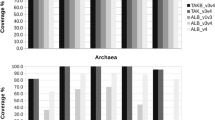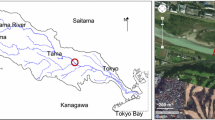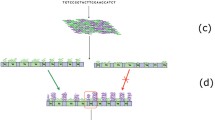Abstract
The 16S ribosomal RNA (rRNA) gene has been the most commonly used sequence to characterize bacterial communities. The classical approach to obtain gene sequences to study bacterial diversity implies cloning amplicons, selecting clones, and Sanger sequencing cloned fragments. A more recent approach is direct sequencing of millions of genes using massive parallel technologies, allowing a large-scale biodiversity analysis of many samples simultaneously. However, currently, this technique is still expensive when applied to few samples; therefore, the classical approach is still used. Recently, we found a community able to remove 50 mg/L Pd(II). In this work, aiming to identify the bacteria potentially involved in Pd(II) removal, the separation of urea/heat-denatured DNA fragments by urea–agarose gel electrophoresis was applied for the first time to select 16S rRNA-cloned amplicons for taxonomic studies. The major raise in the percentage of bacteria belonging to genus Clostridium sensu stricto from undetected to 21 and 41 %, respectively, for cultures without, with 5 and 50 mg/L Pd(II) accompanying Pd(II) removal point to this taxa as a potential key agent for the bio-recovery of this metal. Despite sulfate-reducing bacteria were not detected, the hypothesis of Pd(II) removal by activity of these bacteria cannot be ruled out because a slight decrease of sulfate concentration of the medium was verified and the formation of PbS precipitates seems to occur. This work also contributes with knowledge about suitable partial 16S rRNA gene regions for taxonomic studies and shows that unidirectional sequencing is enough when Sanger sequencing cloned 16S rRNA genes for taxonomic studies to genus level.

Similar content being viewed by others
References
Alexandrino M, Costa R, Canário A, Costa MC (2014) Clostridia initiate heavy metal bio-removal in mixed sulfidogenic cultures for acid mine drainage bioremediation. Environ Sci Technol 48:3378–3385. doi:10.1021/es4052044
Armougom F, Raoult D (2009) Exploring microbial diversity using 16S rRNA high-throughput methods. J Comput Sci Syst Biol 2:74–92. doi:10.4172/jcsb.1000019
Baker GC, Smith JJ, Cowan DA (2003) Review and re-analysis of domain-specific 16S primers. J Microbiol Methods 55:541–555. doi:10.1016/j.mimet.2003.08.009
Baxter-Plant VS, Mikheenko IP, Macaskie LE (2003) Sulphate reducing bacteria, palladium and the reductive dehalogenation of chlorinated aromatic compounds. Biodegradation 14:83–90. doi:10.1023/A:1024084611555
Becker K, Harmsen D, Mellmann A, Meier C, Schumann P, Peters G, von Eiff C (2004) Development and evaluation of a quality-controlled ribosomal sequence database for 16S ribosomal DNA-based identification of Staphylococcus species. J Clin Microbiol 42:4988–4995. doi:10.1128/JCM.42.11.4988-4995.2004
Castro HF, Williams NH, Ogram A (2000) Phylogeny of sulfate-reducing bacteria. FEMS Microbiol Ecol 31:1–9. doi:10.1111/j.1574-6941.2000.tb00665.x
Chakravorty S, Helb D, Burday M, Connell N, Alland D (2007) A detailed analysis of 16S ribosomal RNA gene segments for the diagnosis of pathogenic bacteria. J Microbiol Methods 69:330–339. doi:10.1016/j.mimet.2007.02.005
Chidambaram D, Hennebel T, Taghavi S, Mast J, Boon N, Verstraete W, van der Lelie D, Fitts JP (2010) Concomitant microbial generation of palladium nanoparticles and hydrogen to immobilize chromate. Environ Sci Technol 44:7635–7640. doi:10.1021/es101559r
Clarridge 3rd JE (2004) Impact of 16S rRNA gene sequence analysis for identification of bacteria on clinical microbiology and infectious diseases. Clin Microbiol Rev 17:840–862. doi:10.1128/CMR.17.4
Cole JR, Wang Q, Fish JA, Chai B, McGarrell DM, Sun Y, Brown CT, Porras-Alfaro A, Kuske CR, Tiedje JM (2014) Ribosomal database project: data and tools for high throughput rRNA analysis. Nucl Acids Res 42(Database issue):D633–D642. doi:10.1093/nar/gkt1244
Daly K, Sharp RJ, McCarthy AJ (2000) Development of oligonucleotide probes and PCR primers for detecting phylogenetic subgroups of sulfate-reducing bacteria. Microbiology 146:1693–1705
De Corte S, Hennebel T, De Gusseme B, Verstraete W, Boon N (2012) Biopalladium: from metal recovery to catalytic applications. Microb Biotechnol 5:5–17. doi:10.1111/j.1751-7915.2011.00265.x
De Windt W, Aelterman P, Verstraete W (2005) Bioreduction deposition of palladium(0) nanoparticles on Shewanella oneidensis with catalystic activity towards reductive dechlorination of polychlorinated biphenyls. Environ Microbiol 7:314–325. doi:10.1111/j.1462-2920.2005.00696.x
Deplanche K, Caldelari I, Mikheenko IP, Sargent F, Macaskie LE (2010) Involvement of hydrogenases in the formation of highly catalytic Pd(0) nanoparticles by bioreduction of Pd(II) using Escherichia coli mutant strains. Microbiol 156:2630–2640. doi:10.1099/mic.0.036681-0
Deplanche K, Bennett JA, Mikheenko IP, Omajali J, Wells AS, Meadows RE, Wood J, Macaskie LE (2014) Catalytic activity of biomass-supported Pd nanoparticles: influence of the biological component in catalytic efficacy and potential application in ‘green’ synthesis of fine chemicals and pharmaceuticals. Appl Catal B 147:651–665. doi:10.1016/j.apcatb.2013.09.045
Devereux R, Delaney M, Widdel F, Stahl DA (1989) Natural relationships among sulfate-reducing eubacteria. J Bacteriol 171:6689–6695
Dijkshoorn L, BVan VH, Tjernberg I, Bouvet PJ, Vaneechoutte M (1998) Evaluation of amplified ribosomal DNA restriction analysis for identification of Acinetobacter genomic species. Syst Appl Microbiol 21:33–39. doi:10.1016/S0723-2020(98)80006-4
Fedorovich V, Knighton MC, Pagaling E, Ward FB, Free A, Goryanin I (2009a) Novel electrochemically active bacterium phylogenetically related to Arcobacter butzleri, isolated from a microbial fuel cell. Appl Environ Microbiol 75:7326–7334. doi:10.1128/AEM.01345-09
Fedorovich V, Varfolomeev SD, Sizov A, Goryanin I (2009b) Multielectrode microbial fuel cell with horizontal liquid flow. Water Sci Technol 60:347–355. doi:10.2166/wst.2009.139
Fischer SG, Lerman LS (1979) Length-independent separation of DNA restriction fragments in two-dimensional gel electrophoresis. Cell 16:191–200. doi:10.1016/0092-8674(79)90200-9
Fox GE, Magrum LJ, Balch WE, Wolfe RS, Woese CR (1977) Classification of methanogenic bacteria by 16S ribosomal RNA characterization. Proc Natl Acad Sci U S A 74:4537–4541
Gascuel O (1997) BIONJ: an improved version of the NJ algorithm based on a simple model of sequence data. Mol Biol Evol 14:685–695. doi:10.1093/oxfordjournals.molbev.a025808
Guindon S, Dufayard JF, Lefort V, Anisimova M, Hordijk W, Gascuel O (2010) New algorithms and methods to estimate maximum-likelihood phylogenies: assessing the performance of PhyML 3.0. Syst Biol 59:307–321. doi:10.1093/sysbio/syq010
Hall TA (1999) BioEdit: a user-friendly biological sequence alignment editor and analysis program for Windows 95/98/NT. Nucl Acids Symp Ser 41:95–98
Hamady M, Walker JJ, Harris JK, Gold NJ, Knight R (2008) Error-correcting barcoded primers for pyrosequencing hundreds of samples in multiplex. Nat Methods 5:235–237. doi:10.1038/nmeth.1184
Hegedüs É, Kókai E, Kotlyar A, Dombrádi V, Szabó G (2009) Separation of 1–23-kb complementary DNA strands by urea–agarose gel electrophoresis. Nucleic Acids Res 37:e112. doi:10.1093/nar/gkp539
Hennebel T, Van Nevel S, Verschuere S, De Corte S, De Gusseme B, Cuvelier C, Fitts JP, van der Lelie D, Boon N, Verstraete W (2011) Palladium nanoparticles produced by fermentatively cultivated bacteria as catalyst for diatrizoate removal with biogenic hydrogen. Appl Environ Microbiol 91:1435–1445. doi:10.1007/s00253-011-3329-9
Ishida S, Lee J, Thiele DJ, Herskowitz I (2002) Uptake of the anticancer drug cisplatin mediated by the copper transporter Ctr1 in yeast and mammals. Proc Natl Acad Sci U S A 99:14298–14302. doi:10.1073/pnas.162491399
Jung Y, Lipapard SJ (2007) Direct cellular responses to platinum-induced DNA damage. Chem Rev 107:1387–1407. doi:10.1021/cr068207j
Kanno M, Katayama T, Tamaki H, Mitani Y, Meng XY, Hori T, Narihiro T, Morita N, Hoshino T, Yumoto I, Kimura N, Hanada S, Kamagata Y (2013) Isolation of butanol- and isobutanol-tolerant bacteria and physiological characterization of their butanol tolerance. Appl Environ Microbiol 79:6998–7005. doi:10.1128/AEM.02900-13
Kapdi AR, Fairlamb IJS (2014) Anti-cancer palladium complexes: a focus on PdX2L2, palladacycles and related complexes. Chem Soc Rev 43:4751–4777. doi:10.1039/c4cs00063c
Karr EA, Sattley WM, Rice MR, Jung DO, Madigan MT, Achenbach LA (2005) Diversity and distribution of sulfate-reducing bacteria in permanently frozen Lake Fryxell, McMurdo Dry Valleys, Antarctica. Appl Environ Microbiol 71:6353–6359. doi:10.1128/AEM.71.10.6353-6359.2005
Klindworth A, Pruesse E, Schweer T, Peplies J, Quast C, Horn M, Glöckner FO (2013) Evaluation of general 16S ribosomal RNA gene PCR primers for classical and next-generation sequencing-based diversity studies. Nucl Acids Res 41(1):e1. doi:10.1093/nar/gks808
Kobayashi T, Lu J, Li Z, Hung VS, Kurata A, Hatada Y, Takai K, Ito S, Horikoshi K (2007) Extremely high alkaline protease from a deep-subsurface bacterium, Alkaliphilus transvaalensis. Appl Microbiol Biotechnol 75:71–80. doi:10.1007/s00253-006-0800-0
Kopecky J, Nesvorna M, Mareckova-Sagova M, Hubert J (2014) The effect of antibiotics on associated bacterial community of stored product mites. PLoS One 9:e112919. doi:10.1371/journal.pone.0112919
Liu Z, DeSantis TZ, Andersen GL, Knight R (2008) Accurate taxonomy assignments from 16S rRNA sequences produced by highly parallel pyrosequencers. Nucleic Acids Res 36:e120. doi:10.1093/nar/gkn491
Liu Z, Lozupone C, Hamady M, Bushman FD, Knight R (2007) Short pyrosequencing reads suffice for accurate microbial community analysis. Nucleic Acids Res 35:e120. doi:10.1093/nar/gkm541
Martins M, Faleiro ML, Barros RJ, Veríssimo AR, Barreiros MA, Costa MC (2009) Characterization and activity studies of highly heavy metal resistant sulphate-reducing bacteria to be used in acid mine drainage treatment. J Hazard Mater 166:706–713. doi:10.1016/j.jhazmat.2008.11.088
Martins M, Assunção A, Martins H, Matos AP, Costa MC (2013) Palladium recovery as nanoparticles by an anaerobic bacterial community. J Chem Tech Biotechnol 88:2039–2044. doi:10.1002/jctb.4064
Mizrahi-Man O, Davenport ER, Gilad Y (2013) Taxonomic classification of bacterial 16S rRNA genes using short sequencing reads: evaluation of effective study designs. PLoS One 8(1):e53608. doi:10.1371/journal.pone.0053608
Mori H, Maruyama F, Kato H, Toyoda A, Dozono A, Ohtsubo Y, Nagata Y, Fujiyama A, Tsuda M, Kurokawa K (2014) Design and experimental application of a novel non-degenerate universal primer set that amplifies prokaryotic 16S rRNA genes with a low possibility to amplify eukaryotic rRNA genes. DNA Res 21:217–227. doi:10.1093/dnares/dst052
Odom JM, Peck Jr HD (1984) Hydrogenase, electron transfer proteins, and energy coupling in the sulfate-reducing bacteria Desulfovibrio. Annu Rev Microbiol 38:551–592. doi:10.1146/annurev.mi.38.100184.003003
Orita M, Iwahana H, Kanazawa H, Hayashi K, Sekiya T (1989) Detection of polymorphisms of human DNA by gel electrophoresis as single-strand conformation polymorphisms. Proc Natl Acad Sci U S A 86:2766–2770
Pollmann K, Raff J, Merroun M, Fahmy K, Selenska-Pobell S (2006) Metal binding by bacteria from uranium mining waste piles and its technological applications. Biotechnol Adv 24:58–68. doi:10.1016/j.biotechadv.2005.06.002
Postgate JR (1984) The sulfate-reducing bacteria, 2nd edn. Cambridge University Press, Cambridge
Roh Y, Chon CM, Moon JW (2007) Metal reduction and biomineralization by an alkaliphilic metal-reducing bacterium, Alkaliphilus metalliredigens. J Geosci 11(4):415–423. doi:10.1007/BF02857056
Rosenbaum V, Riesner D (1987) Temperature-gradient gel electrophoresis-thermodynamic analysis of nucleic acids and proteins in purified form and in cellular extracts. Biophys Chem 26:235–246. doi:10.1016/0301-4622(87)80026-1
Sánchez-Andrea I, Sanz JL, Bijmans MFM, Stams AJM (2014) Sulfate reduction at low pH to remediate acid mine drainage. J Hazard Mater 269:98–109. doi:10.1016/j.jhazmat.2013.12.032
Silva GM (2015) Taxonomical and functional diversity of microbial communities in saline-alkaline lakes from Brazilian Pantanal. Masters dissertation. Escola Superior de Agricultura Luiz de Queiroz, Universidade de São Paulo, São Paulo, Brasil (http://www.teses.usp.br/teses/disponiveis/11/11138/tde-29042015-151009/, 2015–07-17)
Sogin ML, Morrison HG, Huber JA, Mark Welch D, Huse SM, Neal PR, Arrieta JM, Herndl GJ (2006) Microbial diversity in the deep sea and the underexplored ‘rare biosphere’. Proc Natl Acad Sci U S A 103:12115–12120. doi:10.1073/pnas.0605127103
Stoddard SF, Smith BJ, Hein R, Roller BRK, Schmidt TM (2014) rrnDB: improved tools for interpreting rRNA gene abundance in bacteria and archaea and a new foundation for future development. Nucleic Acids Res. doi:10.1093/nar/gku1201
Suzuki Y, Kelly SD, Kemner KM, Banfield JF (2003) Microbial populations stimulated for hexavalent uranium reduction in uranium mine sediment. Appl Environ Microbiol 69:1337–1346. doi:10.1128/AEM.69.3.1337-1346.2003
Tamura K, Stecher G, Peterson D, Filipski A, Kumar S (2013) MEGA6: Molecular Evolutionary Genetics Analysis Version 6.0. Mol Biol Evol 30:2725–2729. doi:10.1093/molbev/mst197
Vargas I, Macaskie LE, Guibal E (2004) Biosorption of palladium and platinum by sulfate-reducing bacteria. J Chem Technol Biotechnol 79:49–56. doi:10.1002/jctb.928
Větrovský T, Baldrian P (2013) The variability of the 16S rRNA gene in bacterial genomes and its consequences for bacterial community analyses. PLoS One 8:e57923. doi:10.1371/journal.pone.0057923
Wagner M, Roger AJ, Flax JL, Brusseau GA, Stahl DA (1998) Phylogeny of dissimilatory sulfite reductases supports an early origin of sulfate respiration. J Bacteriol 180:2975–2982
Wang Q, Garrity GM, Tiedje JM, Cole JR (2007) Naive Bayesian classifier for rapid assignment of rRNA sequences into the new bacterial taxonomy. Appl Environ Microbiol 73:5261–5267. doi:10.1128/AEM.00062-07
Weisburg WG, Barns SM, Pelletier DA, Lane DJ (1991) 16S ribosomal DNA amplification for phylogenetic study. J Bacteriol 173:697–703
Wilhelm L, Besemer K, Fasching C, Urich T, Singer GA, Quince C, Battin TJ (2014) Rare but active taxa contribute to community dynamics of benthic biofilms in glacier-fed streams. Environ Microbiol 16:2514–2524. doi:10.1111/1462-2920.12392
Wilson DA, Reischl U, Hall GS, Procop GW (2007) Use of partial 16S rRNA gene sequencing for identification of Legionella pneumophila and Non-pneumophila Legionella spp. J Clin Microbiol 45:257–258. doi:10.1128/JCM.01552-06
Woese CR, Fox G (1977) Phylogenetic structure of the prokaryotic domain: the primary kingdoms. Proc Natl Acad Sci U S A 74:5088–5090. doi:10.1073/pnas.74.11.5088
Yarza P, Richter M, Peplies J, Euzeby J, Amann R, Schleifer KH, Ludwig W, Glöckner FO, Rossello-Mora R (2008) The All-Species Living Tree Project: a 16S rRNA-based phylogenetic tree of all sequenced type strains. Syst Appl Microbiol 31:241–250. doi:10.1016/j.syapm.2008.07.001
Yarza P, Yilmaz P, Pruesse E, Glöckner FO, Ludwig W, Schleifer KH, Whitman WB, Euzeby J, Amann R, Rossello-Mora R (2014) Uniting the classification of cultured and uncultured bacteria and archaea using 16S rRNA gene sequences. Nat Rev Microbiol 12:635–645. doi:10.1038/nrmicro3330
Yong P, Farr JPG, Harris IR, Macaskie LE (2002) Palladium recovery by immobilized cells of Desulfovibrio desulfuricans using hydrogen as the electron donor in a novel electrobioreactor. Biotechnol Lett 24:205–212. doi:10.1023/A:1014141610562
Zhu T, Zhang Y, Quan X, Li H (2015) Effects of an electric field and iron electrode on anaerobic denitrification at low C/N ratios. Chem Eng J 266:241–248. doi:10.1016/j.cej.2014.12.082
Acknowledgments
The authors wish to thank Fundação para a Ciência e a Tecnologia (FCT) for funding this research through the PhD grant SFRH/BD/77093/2011 and through the project UID/Multi/04326/2013.
Author information
Authors and Affiliations
Corresponding author
Ethics declarations
Conflict of interest
All authors declare that they have no competing interests.
Ethical approval
This article does not contain any studies with human participants or animals performed by any of the authors.
Electronic Supplementary Material
ESM 1
(PDF 3.87 mb)
Rights and permissions
About this article
Cite this article
Assunção, A., Costa, M.C. & Carlier, J.D. Application of urea–agarose gel electrophoresis to select non-redundant 16S rRNAs for taxonomic studies: palladium(II) removal bacteria. Appl Microbiol Biotechnol 100, 2721–2735 (2016). https://doi.org/10.1007/s00253-015-7163-3
Received:
Revised:
Accepted:
Published:
Issue Date:
DOI: https://doi.org/10.1007/s00253-015-7163-3




